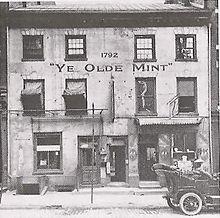
"Ye olde" is a pseudo–Early Modern English phrase originally used to suggest a connection between a place or business and Merry England (or the medieval period). The term dates to the 1850s or earlier;[1] it continues to be used today, albeit now more frequently in an ironically anachronistic fashion.[1]
History
Use of "ye olde" dates at least to the late 18th century. The use of the term "ye" to mean "the" derives from Early Modern English, in which the was written þe, employing the Old English letter thorn, þ. During the Tudor period, the scribal abbreviation for þe was ![]() ("þͤ" or "þᵉ" with modern symbols); here, the letter ⟨þ⟩ is combined with the letter ⟨e⟩.[2] Because ⟨þ⟩ and ⟨y⟩ look nearly identical in medieval English blackletter (as the ⟨þ⟩ in
("þͤ" or "þᵉ" with modern symbols); here, the letter ⟨þ⟩ is combined with the letter ⟨e⟩.[2] Because ⟨þ⟩ and ⟨y⟩ look nearly identical in medieval English blackletter (as the ⟨þ⟩ in ![]() , compared with the ⟨y⟩ in ye), the two have since been mistakenly substituted for each other. The connection became less obvious after the letter thorn was discontinued in favour of the digraph ⟨th⟩. Today, ye is often incorrectly pronounced as the archaic pronoun of the same spelling.[1]
, compared with the ⟨y⟩ in ye), the two have since been mistakenly substituted for each other. The connection became less obvious after the letter thorn was discontinued in favour of the digraph ⟨th⟩. Today, ye is often incorrectly pronounced as the archaic pronoun of the same spelling.[1]
